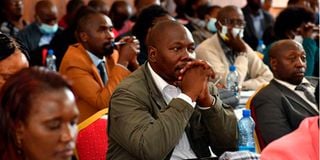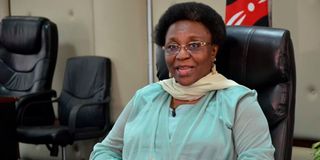Premium
Universities, tertiary institutions ready for first CBC cohort

Participants follow proceedings during the launch of Competency Based Curriculum training for over 60,000 secondary school teachers in preparation of Junior Secondary School at the Kenya Institute of Special Education on April 26, 2022.
What you need to know:
- At secondary school level, students will have an opportunity to utilise technical and vocational education training.
- It is estimated that about 15 per cent of the 1,247,140 currently in the pioneer CBC class are projected to join university.
The Ministry of Education, through the State Department of Curriculum Reforms, has begun discussions with universities ahead of roll out of the competency-based curriculum (CBC) in the institutions.
The principal secretary, Prof Fatuma Chege, assured stakeholders that universities were fully represented and gave their views on how the institutions should go about preparing to admit the first CBC cohort in 2029. She said this during the deliberations of the CBC Taskforce Committee.
“The reforms in the CBC start from early childhood education, primary schools, junior secondary, senior secondary and tertiary institutions, including universities, and must be CBC compliant,” she said.
Based on trends of the Kenya Certificate of Secondary Education (KCSE), it is estimated that about 15 per cent of the 1,247,140 currently in the pioneer CBC class, translating to (183,080), are projected to join university. The remaining 85 percent (1,064,060) are expected to transit to other tertiary institutions.
Currently, the CBC starts at Grade Six and will be rolled out in junior secondary in January next year. The curriculum is designed to expose students to their career interests right after joining junior secondary school and thereafter to choose their career pathways in senior secondary school. Each senior secondary school should offer at least two pathways.
According to the CBC taskforce report, at senior secondary school, learners will pursue three pathways, 60 percent of them science, technology, engineering and mathematics courses (Stem), 25 percent, social sciences and 15 percent sports, science and art sciences. At university level, the CBC will require universities to align their programmes to accommodate students who will have gone through the three pathways at senior secondary.
The taskforce report has recommended that the Commission for University Education (CUE) fast tracks development and review of university programmes to align with the three pathways. Presently, most universities have shifted their focus from their niche programmes to offer courses in areas of arts and business in an effort to attract more students. This has been attributed by education stakeholders as a major cause of unemployment.
According to the Kenya Economic Survey (2021), the country lost over 187,300 formal jobs as at June 2020. Over 800,000 students graduate yearly from various colleges and universities, but only a few of them secure jobs.
At secondary school level, students will have an opportunity to utilise technical and vocational education training (Tvets) institutions near them to gain exposure to various training courses. The idea is to develop trade people, craftspeople, technicians and professional practitioners in careers such as engineering, accountancy, nursing, and medicine and architecture at an early age.
In the KICD Basic Education Curriculum Framework, senior secondary will lay a foundation for further education and training for students at the tertiary level and the world of work.

Prof Fatuma Chege is the Principal Secretary, Education Ministry State Department for the Implementation of the Competency Based Curriculum.
“At this level, learners are ready to specialise in a career path of choice since they have had opportunities to explore their own potential, interests and personality,” reads the framework.
In countries such as Canada, introduction of pathways at secondary level has helped young people to graduate from high school and successfully transition into post-secondary education, training or employment. Other countries such as Malaysia, Sweden, and New Zealand have also embraced the system of introducing career pathways to students in senior secondary school, addressing the barriers that stand in the way of college and university graduates when seeking for either self-employment or formal employment.
In the arts and sports science pathway, learners will be able to participate in the economic development of the country through utilisation of their talents. In middle-level colleges or universities they will pursue careers in the visual or performing arts and the sports industry. The pathway will also prepare learners for careers in the sports industry.
The social science pathway is designed to provide learners with skills for productive problem solving, decision making, creative thinking and making balanced value judgements in physical and social environment.
As for the Stem pathway, it will expose students to the use of technology to develop a labour force that will drive Kenya’s economy. Learners will be exposed to pure sciences, applied sciences, technical engineering, and, career and technology studies (CTS). Graduates of the CTS will be awarded certificates at the completion of Grade 12 and artisan equivalent certificates, making them eligible to join industries to work under the guidance of experienced persons to acquire on the job skill.
Career opportunities will include areas such as beauty, plumbing, welding, tailoring, catering, mechanics, tour guiding.
“They are also eligible to pursue further training in middle level colleges as a prerequisite to joining universities,” reads the framework.
Those pursuing pure sciences will be expected to join a university or a middle level college to pursue careers in the areas of education, medicine, pharmacy, science, industrial science and actuarial science. The pathway will also allow some to join the job market under experienced persons and undergo further training and apprenticeships to advance their skills, while technical engineering students will acquire competencies in pre-technical and pre-career education at junior secondary school.
“Learners graduating from this track at senior secondary will have acquired skills that qualify them to join the industry sector and work under experience personnel or join a technical training institution or university to pursue courses in engineering and technology,” the framework further explains.
Learners with special needs are accommodated too, and will be exposed to skills and competencies that will instil in them skills for the job market based on their interests.





